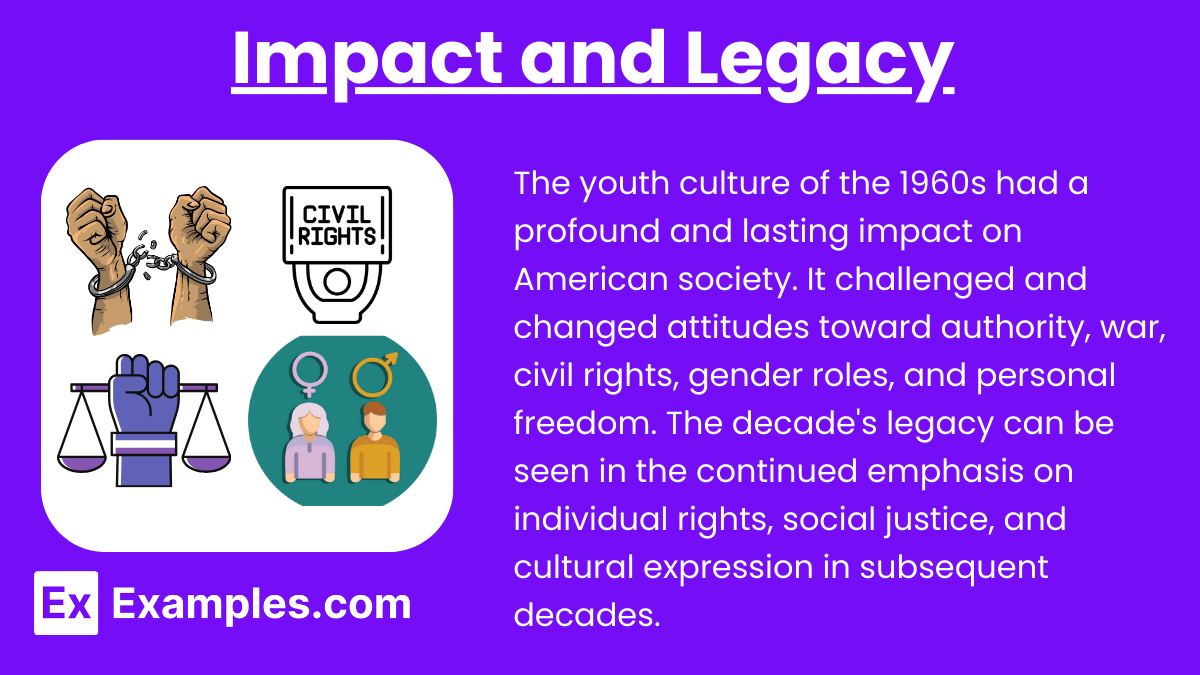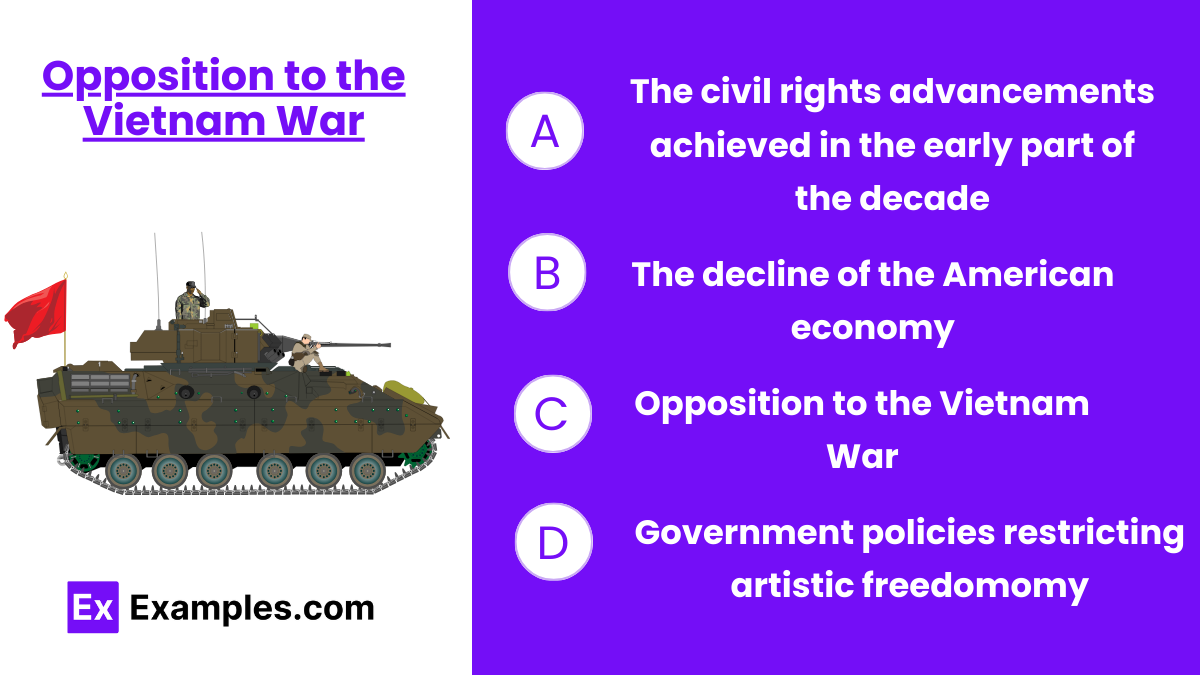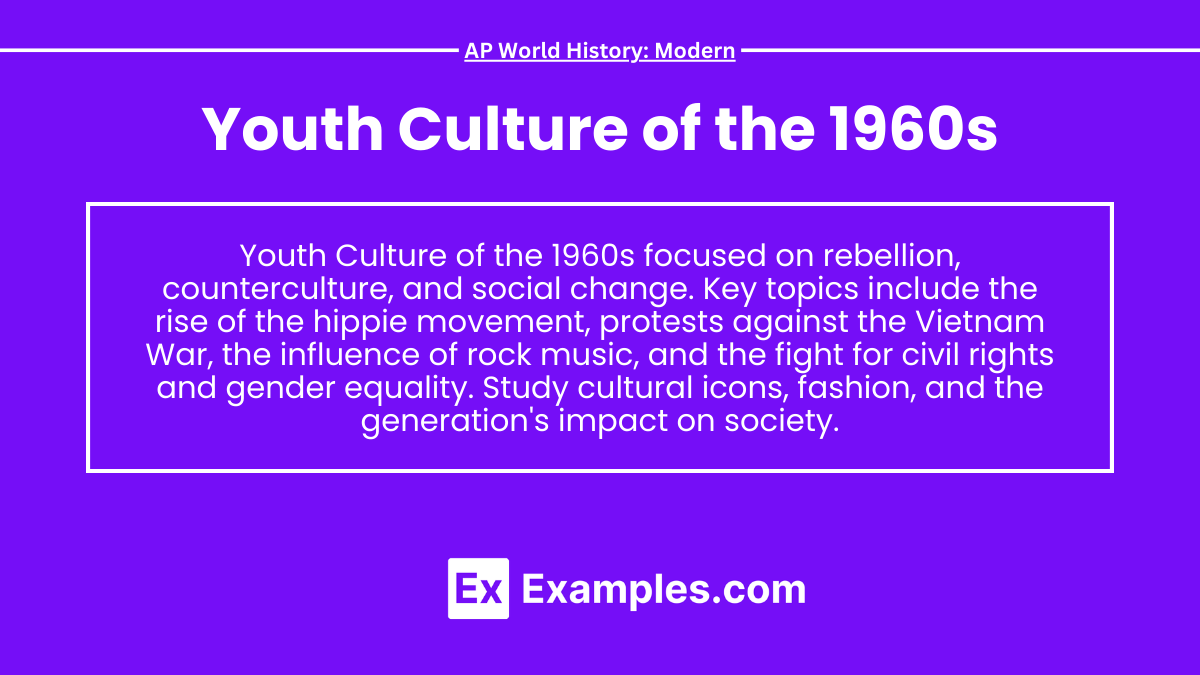In AP United States History, the youth culture of the 1960s is studied as a pivotal period of social and cultural transformation, driven by the Baby Boomer generation’s challenge to traditional values and authority. This era saw the rise of the counterculture, anti-war protests, civil rights activism, and the sexual revolution, all of which reshaped American society. Youth movements during the 1960s not only influenced music, art, and fashion but also played a critical role in advancing social justice and expanding individual freedoms.
Learning Objectives
In studying “Youth Culture of the 1960s” for AP World History: Modern, you should learn to identify the key characteristics of youth culture during this transformative decade, including the rise of counterculture, music, fashion, and activism. Analyze how movements such as the Civil Rights Movement, anti-Vietnam War protests, and the feminist movement influenced youth identity and engagement. Evaluate the role of media, particularly music festivals like Woodstock and the emergence of rock and roll, in shaping cultural values and social norms. Additionally, explore the impact of youth culture on broader societal changes, including shifts in attitudes toward authority, race, gender, and personal freedom.
Key Aspects of Youth Culture in the 1960s:

- Counterculture Movement:
- The counterculture, often associated with the “hippie” movement, rejected mainstream American values, including materialism, consumerism, and the Vietnam War. This movement embraced alternative lifestyles, communal living, and an emphasis on peace, love, and personal freedom.
- The counterculture was also characterized by the use of psychedelic drugs, such as LSD, which were believed to expand consciousness and promote spiritual awakening.
- Anti-War Protests:
- The Vietnam War was a significant catalyst for youth activism in the 1960s. College students and young people were at the forefront of the anti-war movement, organizing protests, marches, and demonstrations to demand an end to U.S. involvement in Vietnam.
- The 1968 Democratic National Convention in Chicago became a focal point for anti-war protests, leading to violent clashes between demonstrators and police, symbolizing the deep divisions in American society over the war.
- Civil Rights Movement:
- Young people were also heavily involved in the civil rights movement, advocating for racial equality and justice. Groups like the Student Nonviolent Coordinating Committee (SNCC) played a vital role in organizing sit-ins, freedom rides, and voter registration drives in the South.
- The involvement of youth in the civil rights movement brought energy and urgency to the struggle for African American rights and helped to achieve significant legislative victories, such as the Civil Rights Act of 1964 and the Voting Rights Act of 1965.
- Music and Art:
- Music was a powerful force in the youth culture of the 1960s, with artists like Bob Dylan, The Beatles, and Jimi Hendrix becoming symbols of the counterculture. Folk, rock, and psychedelic music provided a soundtrack for the social and political movements of the decade.
- The Woodstock Festival in 1969 epitomized the fusion of music and youth activism, drawing hundreds of thousands of young people together in a celebration of peace, love, and music.
Impact and Legacy:

- The youth culture of the 1960s had a profound and lasting impact on American society. It challenged and changed attitudes toward authority, war, civil rights, gender roles, and personal freedom. The decade’s legacy can be seen in the continued emphasis on individual rights, social justice, and cultural expression in subsequent decades.
- However, the youth movements of the 1960s also faced backlash, leading to a more conservative political climate in the 1970s and beyond.
- The counterculture’s rejection of traditional values also sparked a conservative backlash, contributing to political shifts toward conservatism in the late 20th century, such as the rise of Ronald Reagan in the U.S. and Margaret Thatcher in the U.K.
Examples:
Example 1: The Summer of Love (1967)
The Summer of Love was a social phenomenon centered in San Francisco, where thousands of young people gathered to embrace the ideals of the counterculture, promoting peace, love, and communal living.
Example 2: The Free Speech Movement (1964-1965)
The Free Speech Movement at the University of California, Berkeley, was a student-led protest demanding the right to free speech and academic freedom, becoming a symbol of student activism.
Example 3: Woodstock Festival (1969)
Woodstock was a defining event of the 1960s, where music, counterculture, and youth activism converged in a massive celebration of peace and love.
Example 4: The Student Nonviolent Coordinating Committee (SNCC)
SNCC was a key organization in the civil rights movement, led by young activists who organized sit-ins, freedom rides, and voter registration drives to fight racial segregation and injustice.
Example 5: The Anti-War Moratorium (1969)
The Moratorium to End the War in Vietnam was a massive anti-war demonstration that brought together millions of young people across the country to protest U.S. involvement in Vietnam.
MCQs
Question 1:
Which of the following best describes the primary aim of the counterculture movement of the 1960s?
A) Strengthening traditional family values and patriotic sentiments
B) Opposing established social norms and promoting alternative lifestyles
C) Advocating for government intervention in all aspects of life
D) Supporting the spread of communism in Western societies
Answer: B) Opposing established social norms and promoting alternative lifestyles
Explanation: The counterculture movement of the 1960s was characterized by its opposition to mainstream societal values, including materialism, conformity, and traditional authority. Young people in the movement sought to create alternative ways of living, often embracing communal living, peace, and free expression. The movement was not focused on strengthening traditional values (A) or advocating for government intervention (C). While some youth movements were influenced by socialist or communist ideologies, the broader counterculture was more about personal freedom and lifestyle choices than the spread of communism (D).
Question 2:
What was one of the main causes of widespread protests among youth in the 1960s, particularly in the United States?
A) The civil rights advancements achieved in the early part of the decade
B) The decline of the American economy
C) Opposition to the Vietnam War
D) Government policies restricting artistic freedom

Answer: C) Opposition to the Vietnam War
Explanation: The Vietnam War was a major cause of protests among youth, especially in the U.S. Many young people were opposed to the war due to the draft, the loss of lives, and the perceived imperialism of the U.S. government. Protests, such as the ones on college campuses, were common. While civil rights (A) and economic concerns (B) were important issues, they did not spark the same level of widespread protest. Government policies restricting artistic freedom (D) were not a primary concern for youth protests during this period.
Question 3:
Which event is most closely associated with the peak of the 1960s counterculture movement in the United States?
A) The Cuban Missile Crisis
B) The assassination of John F. Kennedy
C) The Woodstock Music Festival
D) The passage of the Civil Rights Act of 1964
Answer: C) The Woodstock Music Festival
Explanation: The Woodstock Music Festival, held in 1969, is one of the most iconic events of the 1960s counterculture movement. It brought together hundreds of thousands of young people to celebrate peace, music, and love, and is often seen as the culmination of the counterculture movement. While the Cuban Missile Crisis (A) and the assassination of John F. Kennedy (B) were significant historical events, they are not directly related to youth culture. The Civil Rights Act of 1964 (D) was an important legislative achievement, but Woodstock is more emblematic of the counterculture’s values and its peak.


